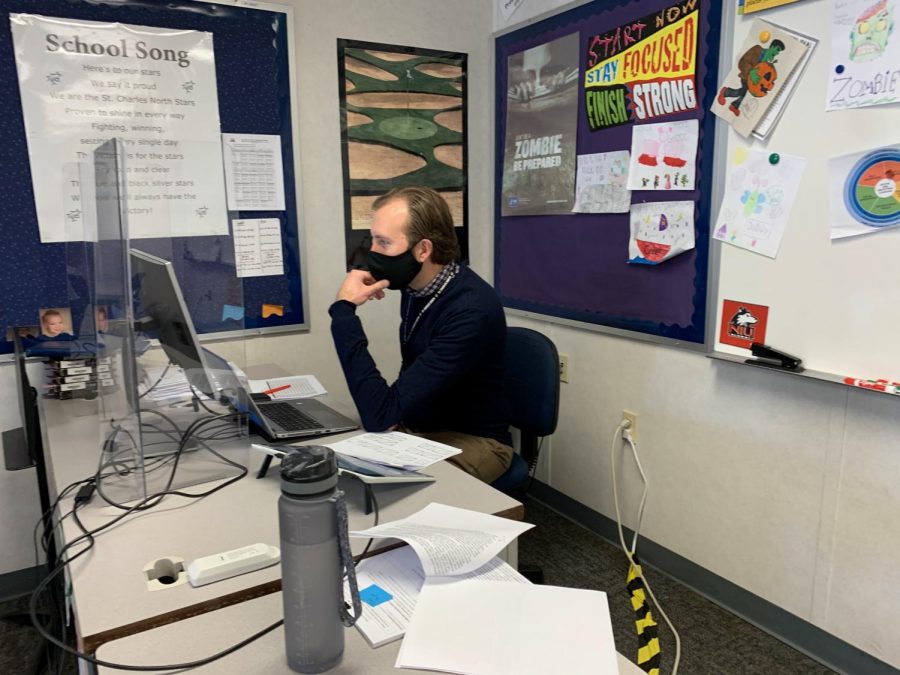Teachers Utilize Online Tools to Keep Students Engaged
English teacher Scott Von Essen navigates several screens so he can have his lesson pulled up while also being able to see the students at home.
January 22, 2021
A Biology class may be studying cell structure, but a student could be at home texting and playing video games. Students can attend class without even getting out of bed in the morning. Students can walk around their house, make food, and talk to other people all while class is going on. These distractions have never been present before in a typical classroom setting. Because of COVID-19, students have had to attend many school days remotely and with that remote learning comes a myriad of new challenges. Teachers have struggled to connect and engage with remote students throughout the school year because of the separation between them and have had to find new ways to engage with their students.
While teachers can easily see how the in-person students are understanding a concept, it is harder for them to see how the remote learners are doing. The lack of students having their cameras on has made it difficult for teachers to tell if students are understanding a concept. In the past, teachers have relied on facial reactions to see if the learning was taking place.
“I put all this energy into it, and I’m worried that they’re not getting it, and then I don’t see any facial reactions,” said Erin Manheim, English teacher.
Teachers have also struggled with students not responding to questions and being scared to unmute. However, some teachers have found that when more students have their cameras on, they are more likely to get a response.
“It takes a little longer than it usually does in person, but I find if their cameras are on and you see their face on the camera, that social pressure makes them more likely to participate,” said Bethany Herrera, psychology teacher.
Teachers have also used digital tools to make sure remote students are actively participating in class. These can help them track student understanding and engagement during class. Online tools can also help teachers make sure students are staying on task and not distracted just because they are in their house.
Some math classes have used Desmos where teachers can see “at that exact moment if there’s a particular student not working on the task that they’re supposed to work on,” said Sarah Fox, math teacher.
Others have made every assignment mandatory and for a grade. In the past, teachers were able to walk around the room and see that kids were participating and doing their work. Now, that is not possible.
“There is no virtual walking around the room. There’s no virtual saying how much you’ve done unless I actually get your work, and I can read your work. And so I’ve turned everything into turning something in at the end of every day so that I can read your work and give you feedback on it to ensure that you are engaging with the content,” said Herrera.
This also helps ensure that students follow along in class and pay attention so that they are better suited for the assignments.
Herrera says students have started to notice that “if they don’t do those things, that makes a difference in their understanding.”
Another way teachers have increased student engagement is by using tools to help students interact with each other. Some classes have used Classkick, a tool that allows students to answer each other’s questions.
“I think that that helps a lot too, with the student engagement, where if there is a student that really knows how to solve this problem, they can use those skills to help other students that feel stuck,” said Fox.
Teachers have also had to change up their lessons so that they better fit a remote setting. Some lessons that they have used in past years might not work anymore.
“I have to really consciously think about how this is going to be different now with concurrent instruction and to make sure that I can see whether or not kids are engaged,” said Manheim.
However, teachers have noticed that students are more likely to interact with their teachers one-on-one. Teachers will set up breakout rooms where students can go to ask questions and talk without the rest of their class.
“That increases their engagement because they have a safe place to ask questions,” said Herrera
Though this year has changed a lot about school, teachers agree that students have adapted to every change in exceptional ways and that they will be able to come out of COVID-19 stronger individuals.
“You students are going to be okay in the long run. As much as this is a struggle, you are genuinely going to be okay in the future,” said Manheim.



